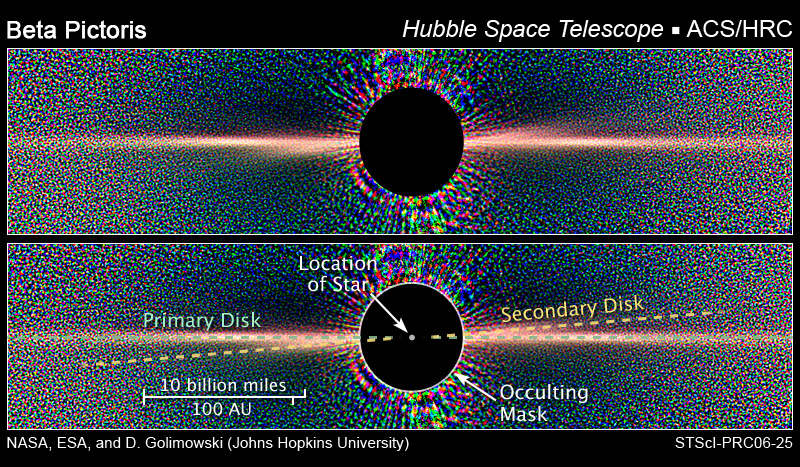Image: HST betaPictoris comb
Description: Hubble Sees Two Dust Disks Around Beta Pictoris This Hubble Space Telescope view of Beta Pictoris clearly shows a primary dust disk and a much fainter secondary dust disk. The secondary disk extends at least 24 billion miles from the star and is tilted roughly 4 to 5 degrees from the primary disk. The secondary disk is circumstantial evidence for the existence of a planet in a similarly inclined orbit. The planet may have indirectly formed the secondary disk by sweeping up smaller planetesimals – chunks of rock and/or ice – from the main disk. The planetesimals then collide, producing the dust seen in the disk. The image, taken with the Advanced Camera for Surveys (ACS), is the sharpest visible-light view of the disks around Beta Pictoris. Astronomers used the Advanced Camera's coronagraph to block out the light from the bright star. The black circle in the center of the image marks the coronagraphic mask. The colorful spike-like features and the speckled background are artifacts of the image processing which removed the residual starlight. The color image reveals that the disk is slightly red. The disk appeared gray in previous images taken by ground-based telescopes. Though astronomers are not sure why the disk is red, they think it is due to compact or fluffy grains of graphite and silicates, which may be as small as smoke particles. The image was taken Oct. 1, 2003.
Title: HST betaPictoris comb
Credit: Hubble News Release, Number: STScI-2006-25: "Hubble Reveals Two Dust Disks Around Nearby Star Beta Pictoris". June 27, 2006
Author: David Golimowski (Johns Hopkins University), NASA, ESA
Permission: NASA PD
Usage Terms: Public domain
License: Public domain
Attribution Required?: No
Image usage
The following page links to this image:


